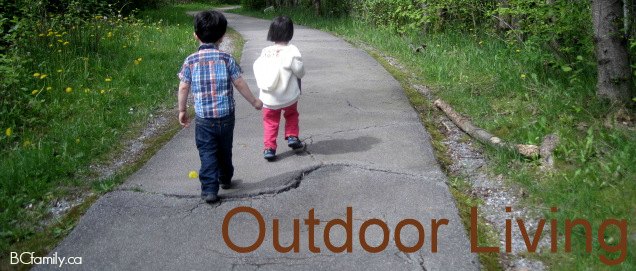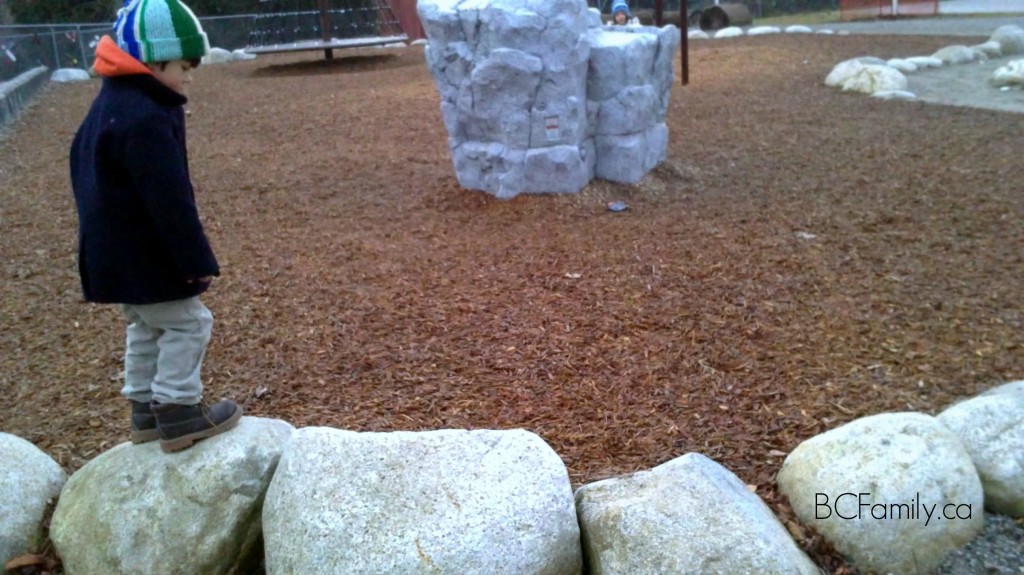Pamela Chan, BCFamily.ca/Editorial
There appears to be very little direction and explanation from adults. Instead, Norwegian staff appear to adopt a quiet, strong, non-invasive adult presence which allows the children to direct their own play, use their imagination, create fantasies and take risks without actually being in danger. On closer inspection, there is also something deeper and more subtle happening which seems to be about sharing and learning across the generations. (Joyce Gilbert writing about the Medas Farm Kindergarten near Fauske, Norway.)
It started with a short film on Vimeo about children exploring the outdoors in Norway. Since then I’ve been catching bits and bytes about the forest kindergarten/outdoor education programmes around the world on blogs, newspaper articles, Facebook and even Twitter. The interest is growing exponentially every year so the amount of material to consider can sometimes feel overwhelming. (If you have the type of mind, like I do, that wants to read everything that’s out there!) I’ve passed by as much information as I’ve read – there’s that much information available. But I can say, confidently, that for me it all started with one viewing of this film.
Since I watched the video about Norwegian outdoor kindergartens about two years ago, the content has been removed. This might be because the full length, 21 minute film is now available for purchase. For now, if you haven’t seen a video about outdoor kindergartens in Norway, you can watch a six minute introduction included above.
In the film Heidi Buvang, an experienced teacher, explains that being happy, outside and in the fresh air is important for children nowadays. This might seem like an obvious statement but ask yourself if the children in your life have that opportunity on a regular basis. Do the requirements of getting by as a family (with school, work and other obligations) get in the way? How are other opportunities such as indoor extra-curricular activities or use of technology competing with the goal to experience and appreciate nature?
Buvang explains that outdoor opportunities encourage children to have a desire to be outside and creative. Thinking about our own childhood experiences, it might seem puzzling to emphasize this point. What I have noticed with my children is that frequent and extended opportunities outside in the company of family members, friends or teachers provides them with skills and jumping off points for their own explorations at a later date.
I couldn’t understand what was being said in this video but it is interesting to watch!
Children in Norway are eligible for full-time care from age one. By the time they are 3 – 5 years old they have the opportunity to be in outdoor schools, all day, for a minimum of one day a week and as much as three days a week. One or two days a year, they stay inside due to dangerously low temperatures. The teachers believe that adults set the example for children. If adults show resilience and provide the right type of outdoor gear, according to a Norwegian saying there is no such thing as “bad weather”.
In many schools in North America, during the last few decades, time outside has been reduced and playground time has diminished as other priorities have taken over. One mother living on the east coast of the United States started a movement to bring back playground time after she noticed local school playgrounds were usually empty. The renaissance of a commitment to outdoor education opportunities in schools districts such as SD #42 (Maple Ridge) is heartening. These initiatives and opportunities are particularly important for children who might not otherwise have opportunities to get outside in natural environments very often. The reasons why are complex and varied.
Other videos about the Environmental School Project in Maple Ridge
In the longer version of the film about Norwegian outdoor kindergartens (numbering almost 1 in every 10 schools) you see that the children regularly climb trees. They are given real tools, such as a hammer, a sharp knife and saw, to use for building projects. These experiences provide opportunities for children to learn about problem solving, working in teams and cooperating. Children bundle up to face, by BC standards, pretty cold weather. When the northern location of Norway involves darkness during the day, children come to school with headlamps on! The videographer mentions that the children in these schools have better balance and walking skills, as they walk regularly on uneven surfaces, than children who are used to more even surfaces. Since hearing about this research, I’ve focussed on providing similar opportunities for my children. In a local Coquitlam school, the new playground has a series of large boulders that surround the playground. My preschool age children enjoy “walking the rocks” and improving their walking skills. In their nature school class they have improved their confidence and ability to clamber over logs or walk along the top of logs.
It is interesting to see that the children in Norway have a covered shelter that they use for resting and eating together. During their days out in the outdoor kindergarten, they really are outside all day. In the full-version of the film parents discuss how they value their child’s opportunity to take part in this type of programme as they didn’t have this type of opportunity when they were growing up. Contrary to what one might expect, the children taking part in these programmes are not sick more often than children in other programmes.
A film about a Norwegian outdoor kindergarten programme made for a Scottish audience.
The approach of teachers in Norway left me with some lasting impressions and conclusions:
* dress well for the weather and throw yourselves outside. (Unless it’s lashing rain outside or someone seems to be sick.)
* think about the skills that the natural environment provides, such as climbing skills.
* monitor your attitude and how you respond to situations. This approach will provide a good model to your children.
* providing opportunities to experience real tasks in the outdoors fosters a feeling of joy and relevance in children.
* opportunities to interact with adults other than yourself in the outdoors exposes children to new inspirations and perspectives.
* try to avoid thinking about the weather and what is happening outside as something that, mentally, you wish you could control. Follow the cycle of nature and the seasons instead of resisting what is happening.
* make it a priority to get outdoors and experience nature. Don’t put off for tomorrow what you could do today.
* prioritize experiences outside over other opportunities that can take over our lives such as use of mobile technology devices.
* keep it simple. Outdoor living and education opportunities don’t have to be complicated or expensive. If you can, enroll in a programme or meet up with others on a regular basis. But you can also develop your own plan for you and your family.
I sometimes find myself having a conversation with other mums that focusses on how we, as mothers, are supporting our children. I tell my conversation partner that if, at a minimum, we can help our children to get outside as much as possible – at least one hour a day – we are fulfilling one of our most important roles.
You can comment about this posting using the comment function below or on the BCFamily.ca Facebook page. Your contribution matters so don’t be shy!
Related
Previous posts about outdoor education
Forum discussion regarding the German model of forest kindergartens – Waldkindergarten
This half hour video gives a good idea about pacing in a Waldkindergarten (outdoor kindergarten) school. It’s a welcome reminder that when we do get out into parks, it’s a good idea to get off the path… at least just a bit!



I really think too that it is very good to go outside as much as possible with the children.
Fresh air is good for the mind and I can see for my son. He is 10 times happier when he goes outside even when it’s raining!
Yesterday it was raining and we were the only one at the playground. Nothing really stop us! We just don’t stay as long as we would like!!!
I definitely agree that it’s important to take the kids outside as much as possible. We try and take walks, go to the park, play in the backyard, driveway etc.. The Norway example is very interesting to learn about. They don’t let weather be an excuse where as here in Vancouver, rain is used as an excuse on many occasion. But they are right, if dressed appropriately, the weather shouldn’t be a deterrent.
It is always interesting to learn about how things are done elsewhere regarding childcare and education. I try to make sure my kids get out daily unless the weather is completely intolerable!
My friends go to the outdoor school in maple ridge and love it! While my oldest is in a traditional school, we spend as much time outdoors as possible. I notice a huge change in their behaviour (even in my one year old), when they haven’t had any outside time. Rain is just an opportunity to splash in the puddles!
This is a great post! I taught in Vancouver schools for several years before teaching in international schools in Hong Kong, Japan and Switzerland. We certainly can learn something of value in from various educational systems (and cultural values) in the world. I haven’t any personal experience with Norwegian education however I have some familiarity with Scandinavian culture in general.
I was delighted to learn that outdoor education for children is valued in Norway. This is so important! Here German-speaking Europe, there is something called Waldkinder (Forest Kindergarten) that really benefits early childhood development. One thing I must say that Vancouver does well is diversity education and living. I wrote a bit about it in this recent blog post here:
http://globalwiseparenting.com/2014/05/the-road-trip-that-led-to-a-global-lifestyle/